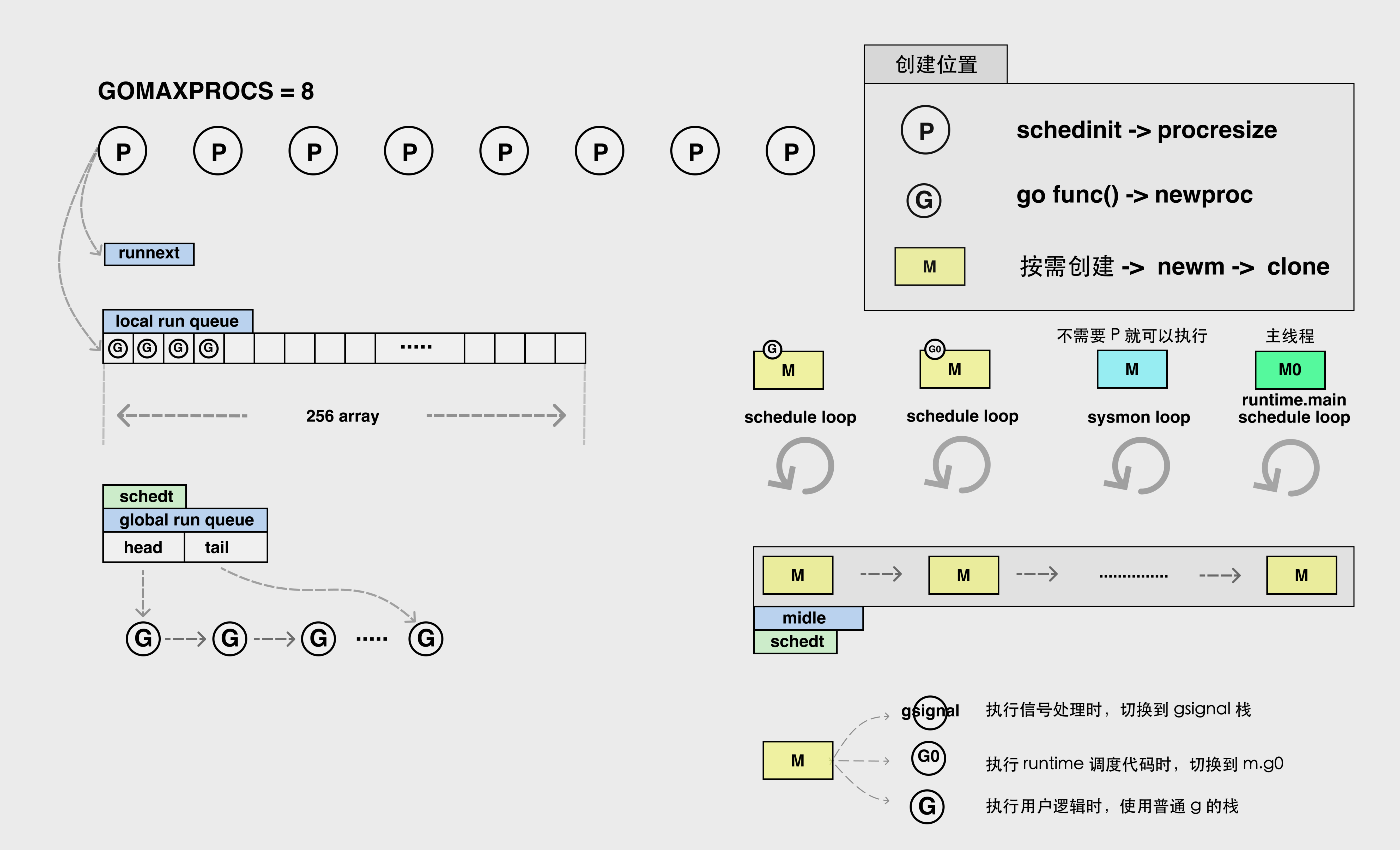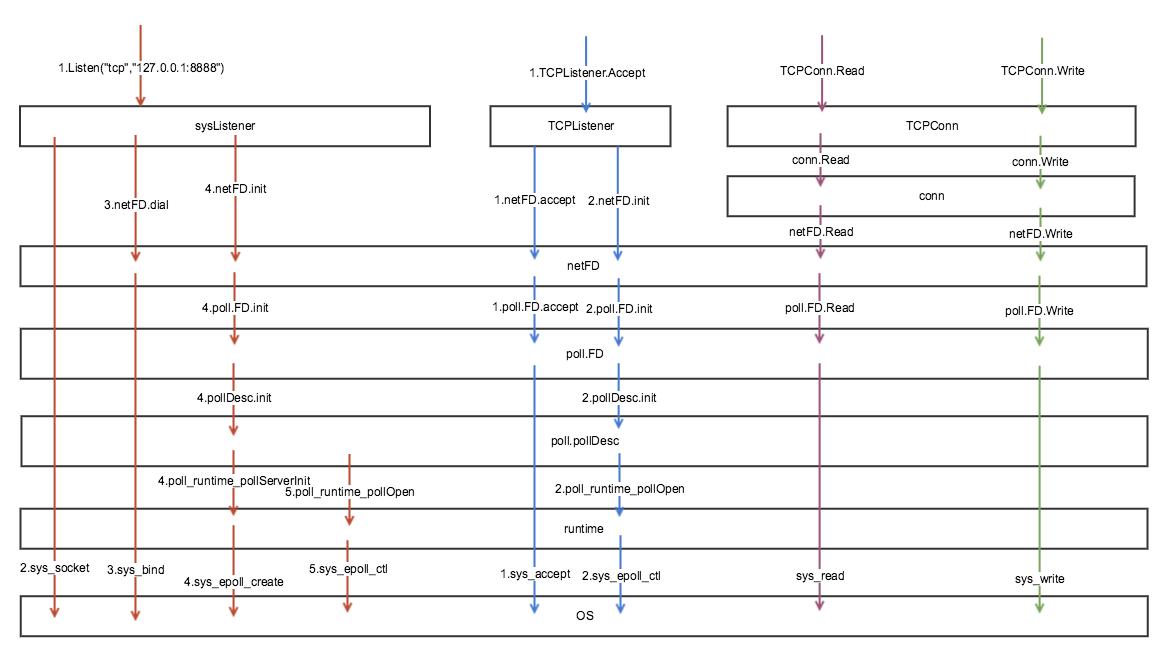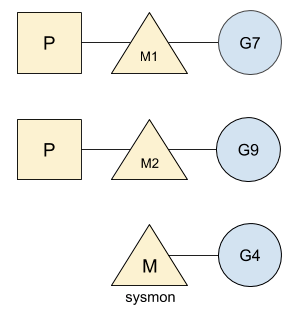

golang netpoll的实现与分析
source link: https://xiaomozhang.github.io/2021/10/12/golang-netpoll-realization-analysis/
Go to the source link to view the article. You can view the picture content, updated content and better typesetting reading experience. If the link is broken, please click the button below to view the snapshot at that time.

1:io模型
计算机的io模型区分为多种,目前用的最多的也就是nio、epoll、select。
结合不同场景使用不同的io模型才是正解。
具体可以查看我之前写的io模型演进。io模型演进
2:golang中网络io
golang天然适合并发,为什么?一个是轻量级的协程,二个是将复杂的io进行了抽象化,简化了流程。
比如我们简单的访问一个http服务,几行简单的代码就能实现
tr := &recordingTransport{}
client := &Client{Transport: tr}
url := "http://dummy.faketld/"
client.Get(url) // Note: doesn't hit network那么golang对Io做了哪些优化呢?能实现如此简单的切换呢?
3:groutinue 针对io事件的调度
我们这里假设你对groutinue调度已经有一定的了解了。
我们知道,在go中,每个process绑定一个虚拟的machine,而在machine中,是具有一个g0的,g0在本地遍历自己的队列获取g或者从全局队列获取g。

我们也知道了,在g运行的时候,g会把执行权交给g0进行重新调度,那么在io事件中,g是怎么把事件交还给g0的呢?这时候就牵扯到我们今天的主角—-netpoll。
4:netpoll
o语言在网络轮询器中使用 I/O 多路复用模型处理 I/O 操作,但是他没有选择最常见的系统调用 select。 select 也可以提供 I/O 多路复用的能力,但是使用它有比较多的限制:
- 监听能力有限 — 最多只能监听 1024 个文件描述符,可以通过手动修改limit来改变,但是各方面成本比较大;
- 内存拷贝开销大 — 需要维护一个较大的数据结构存储文件描述符,该结构需要拷贝到内核中;
- 时间复杂度 — 返回准备就绪的事件个数后,需要遍历所有的文件描述符;
golang官方统一封装一个网络事件的poll,和平台无关,为epoll/kqueue/port/AIX/Windows 提供了特定的实现。
- src/runtime/netpoll_epoll.go
- src/runtime/netpoll_kqueue.go
- src/runtime/netpoll_solaris.go
- src/runtime/netpoll_windows.go
- src/runtime/netpoll_aix.go
- src/runtime/netpoll_fake.go
这些模块在不同平台上实现了相同的功能,构成了一个常见的树形结构。编译器在编译 Go 语言程序时,会根据目标平台选择树中特定的分支进行编译
必须实现的方法有:
netpollinit 初始化网络轮询器,通过 `sync.Once` 和 `netpollInited` 变量保证函数只会调用一次
netpollopen 监听文件描述符上的边缘触发事件,创建事件并加入监听poll_runtime_pollOpen函数,这个函数将用户态协程的pollDesc信息写入到epoll所在的单独线程,从而实现用户态和内核态的关联。
netpoll 轮询网络并返回一组已经准备就绪的 Goroutine,传入的参数会决定它的行为:
- 如果参数小于0,阻塞等待文件就绪
- 如果参数等于0,非阻塞轮询
- 如果参数大于0,阻塞定期轮询
netpollBreak 唤醒网络轮询器,例如:计时器向前修改时间时会通过该函数中断网络轮询器
netpollIsPollDescriptor 判断文件描述符是否被轮询器使用netpoll中有2个重要的结构体:
//pollCache
//pollDesc
type pollDesc struct {
link *pollDesc // in pollcache, protected by pollcache.lock
// The lock protects pollOpen, pollSetDeadline, pollUnblock and deadlineimpl operations.
// This fully covers seq, rt and wt variables. fd is constant throughout the PollDesc lifetime.
// pollReset, pollWait, pollWaitCanceled and runtime·netpollready (IO readiness notification)
// proceed w/o taking the lock. So closing, everr, rg, rd, wg and wd are manipulated
// in a lock-free way by all operations.
// NOTE(dvyukov): the following code uses uintptr to store *g (rg/wg),
// that will blow up when GC starts moving objects.
lock mutex // protects the following fields
fd uintptr
closing bool
everr bool // marks event scanning error happened
user uint32 // user settable cookie
rseq uintptr // protects from stale read timers
rg uintptr // pdReady, pdWait, G waiting for read or nil
rt timer // read deadline timer (set if rt.f != nil)
rd int64 // read deadline
wseq uintptr // protects from stale write timers
wg uintptr // pdReady, pdWait, G waiting for write or nil
wt timer // write deadline timer
wd int64 // write deadline
self *pollDesc // storage for indirect interface. See (*pollDesc).makeArg.
}
type pollCache struct {
lock mutex
first *pollDesc
// PollDesc objects must be type-stable,
// because we can get ready notification from epoll/kqueue
// after the descriptor is closed/reused.
// Stale notifications are detected using seq variable,
// seq is incremented when deadlines are changed or descriptor is reused.
}rseq和wseq— 表示文件描述符被重用或者计时器被重置;rg和wg— 表示二进制的信号量,可能为 pdReady、pdWait、等待文件描述符可读或者可写的 Goroutine 以及 nil;rd和wd— 等待文件描述符可读或者可写的截止日期;rt和wt— 用于等待文件描述符的计时器;
golang关于io时间做了很多统一的封装在runtime/netpoll之下(其实调用的是internal/poll包下的),然后通过internal包下对 runtime包进行调用,internal包下也封装了一个同名的pollDesc对象,不过是一个指针(关于internal有个细节就是这个包是不能被外部调用):其实最终都是对runtime底下的调用,只不过封装了一些易用的方法,比如read,write,做了一些抽象化的处理。type pollDesc struct { runtimeCtx uintptr }这些方法的具体实现都在runtime下,我们挑几个重要的看看:func runtime_pollServerInit() //初始化 func runtime_pollOpen(fd uintptr) (uintptr, int) //打开 func runtime_pollClose(ctx uintptr) //关闭 func runtime_pollWait(ctx uintptr, mode int) int //等待 func runtime_pollWaitCanceled(ctx uintptr, mode int) int //等待并(失败时)退出 func runtime_pollReset(ctx uintptr, mode int) int //重置状态,复用 func runtime_pollSetDeadline(ctx uintptr, d int64, mode int) //设置读/写超时时间 func runtime_pollUnblock(ctx uintptr) // 解锁 func runtime_isPollServerDescriptor(fd uintptr) bool // 这里的ctx实际上是一个io fd,不是上下文 // mod 是 r 或者 w ,io事件毕竟只有有这两种 // d 意义和time.d差不多,就是关于时间的
//将就绪好得io事件,写入就绪的grotion对列
// netpollready is called by the platform-specific netpoll function.
// It declares that the fd associated with pd is ready for I/O.
// The toRun argument is used to build a list of goroutines to return
// from netpoll. The mode argument is 'r', 'w', or 'r'+'w' to indicate
// whether the fd is ready for reading or writing or both.
//
// This may run while the world is stopped, so write barriers are not allowed.
//go:nowritebarrier
func netpollready(toRun *gList, pd *pollDesc, mode int32) {
var rg, wg *g
if mode == 'r' || mode == 'r'+'w' {
rg = netpollunblock(pd, 'r', true)
}
if mode == 'w' || mode == 'r'+'w' {
wg = netpollunblock(pd, 'w', true)
}
if rg != nil {
toRun.push(rg)
}
if wg != nil {
toRun.push(wg)
}
}//轮询时调用的方法,如果io就绪了返回ok,如果没就绪,返回flase
// returns true if IO is ready, or false if timedout or closed
// waitio - wait only for completed IO, ignore errors
func netpollblock(pd *pollDesc, mode int32, waitio bool) bool {
gpp := &pd.rg
if mode == 'w' {
gpp = &pd.wg
}
// set the gpp semaphore to pdWait
for {
old := *gpp
if old == pdReady {
*gpp = 0
return true
}
if old != 0 {
throw("runtime: double wait")
}
if atomic.Casuintptr(gpp, 0, pdWait) {
break
}
}
// need to recheck error states after setting gpp to pdWait
// this is necessary because runtime_pollUnblock/runtime_pollSetDeadline/deadlineimpl
// do the opposite: store to closing/rd/wd, membarrier, load of rg/wg
if waitio || netpollcheckerr(pd, mode) == 0 {
//gopark是很重要得一个方法,本质上是让出当前协程执行权,一般是返回到g0让g0重新调度
gopark(netpollblockcommit, unsafe.Pointer(gpp), waitReasonIOWait, traceEvGoBlockNet, 5)
}
// be careful to not lose concurrent pdReady notification
old := atomic.Xchguintptr(gpp, 0)
if old > pdWait {
throw("runtime: corrupted polldesc")
}
return old == pdReady
}
//获取到当前io所在的协程,如果协程已关闭,直接返回nil
func netpollunblock(pd *pollDesc, mode int32, ioready bool) *g {
gpp := &pd.rg
if mode == 'w' {
gpp = &pd.wg
}
for {
old := *gpp
if old == pdReady {
return nil
}
if old == 0 && !ioready {
// Only set pdReady for ioready. runtime_pollWait
// will check for timeout/cancel before waiting.
return nil
}
var new uintptr
if ioready {
new = pdReady
}
if atomic.Casuintptr(gpp, old, new) {
if old == pdWait {
old = 0
}
return (*g)(unsafe.Pointer(old))
}
}
}1、 a、b两个协程,b io阻塞,完成后,一直没有获取到调度权,会出现什么后果。
2、 a、b两个协程,b io阻塞,2s time out,但是a一直占用执行权,b一直没有获取到调度权,5s后才获得到,b对使用端已经超时,这时候是超时还是不超时
所以设置的timeout,不一定是真实的io waiting,可能是没有获取到执行权。
5:怎么触发读事件的?
因为写io是我们主动操作的,那么读是怎么进行操作的呢?这是一个被动的状态
首先我们了解一个结构体。golang中所有的网络事件和文件读写都用fd进行标识(位于internal包下)。
// FD is a file descriptor. The net and os packages use this type as a
// field of a larger type representing a network connection or OS file.
type FD struct {
// Lock sysfd and serialize access to Read and Write methods.
fdmu fdMutex
// System file descriptor. Immutable until Close.
Sysfd int
// I/O poller.
pd pollDesc
// Writev cache.
iovecs *[]syscall.Iovec
// Semaphore signaled when file is closed.
csema uint32
// Non-zero if this file has been set to blocking mode.
isBlocking uint32
// Whether this is a streaming descriptor, as opposed to a
// packet-based descriptor like a UDP socket. Immutable.
IsStream bool
// Whether a zero byte read indicates EOF. This is false for a
// message based socket connection.
ZeroReadIsEOF bool
// Whether this is a file rather than a network socket.
isFile bool
}我们看到,fd中关联的pollDesc,通过pollDesc调用了runtime包内部的实现的各种平台的io事件。
当我们进行read操作时(下面是代码截取)
for {
n, err := ignoringEINTRIO(syscall.Read, fd.Sysfd, p)
if err != nil {
n = 0
if err == syscall.EAGAIN && fd.pd.pollable() {
if err = fd.pd.waitRead(fd.isFile); err == nil {
continue
}
}
}
err = fd.eofError(n, err)
return n, err
}会阻塞调用waiteRead方法,方法内部主要就是调用的runtime_pollWait。
func poll_runtime_pollWait(pd *pollDesc, mode int) int {
errcode := netpollcheckerr(pd, int32(mode))
if errcode != pollNoError {
return errcode
}
// As for now only Solaris, illumos, and AIX use level-triggered IO.
if GOOS == "solaris" || GOOS == "illumos" || GOOS == "aix" {
netpollarm(pd, mode)
}
for !netpollblock(pd, int32(mode), false) {
errcode = netpollcheckerr(pd, int32(mode))
if errcode != pollNoError {
return errcode
}
// Can happen if timeout has fired and unblocked us,
// but before we had a chance to run, timeout has been reset.
// Pretend it has not happened and retry.
}
return pollNoError
}这里主要是由netpollblock控制,netpollblock方法我们上面就说过,当io还未就绪的时候,直接释放当前的执行权,否则就是已经可读写的io事件,直接进行读取操作即可。
整体流程
listenStream –> bind&listen&init –> pollDesc.Init -> poll_runtime_pollOpen –> runtime.netpollopen -> epollctl(EPOLL_CTL_ADD)

pollDesc是由pollCache进行维护的,并且不受GC监控
// Must be in non-GC memory because can be referenced
// only from epoll/kqueue internals.
mem := persistentalloc(n*pdSize, 0, &memstats.other_sys)
for i := uintptr(0); i < n; i++ {
pd := (*pollDesc)(add(mem, i*pdSize))
pd.link = c.first
c.first = pd
}golang中遇到io事件时,统一对其做了封装,首先建立系统事件(本文主要针对epoll),然后让出cpu(gopark),然后进行协程调度执行其他g。当g io事件完成时,会从epoll进行交互看是否就绪(epoll就绪列表),就绪则pop取出一个g往下执行,未就绪则调度其他g。(其实pop取就绪列表也有一定逻辑,时候延时处理之类的)
runtime/proc.go,
// Finds a runnable goroutine to execute.
// Tries to steal from other P's, get g from local or global queue, poll network.
func findrunnable() (gp *g, inheritTime bool) {
_g_ := getg()
// The conditions here and in handoffp must agree: if
// findrunnable would return a G to run, handoffp must start
// an M.
top:
_p_ := _g_.m.p.ptr()
//......
// Poll network.
// This netpoll is only an optimization before we resort to stealing.
// We can safely skip it if there are no waiters or a thread is blocked
// in netpoll already. If there is any kind of logical race with that
// blocked thread (e.g. it has already returned from netpoll, but does
// not set lastpoll yet), this thread will do blocking netpoll below
// anyway.
if netpollinited() && atomic.Load(&netpollWaiters) > 0 && atomic.Load64(&sched.lastpoll) != 0 {
if list := netpoll(0); !list.empty() { // non-blocking
gp := list.pop()
injectglist(&list)
casgstatus(gp, _Gwaiting, _Grunnable)
if trace.enabled {
traceGoUnpark(gp, 0)
}
return gp, false
}
}
//......
}另外在sysmon中,也对netpoll进行了调度。
// Always runs without a P, so write barriers are not allowed.
//
//go:nowritebarrierrec
func sysmon() {
lock(&sched.lock)
sched.nmsys++
checkdead()
unlock(&sched.lock)
//......
// poll network if not polled for more than 10ms
lastpoll := int64(atomic.Load64(&sched.lastpoll))
if netpollinited() && lastpoll != 0 && lastpoll+10*1000*1000 < now {
atomic.Cas64(&sched.lastpoll, uint64(lastpoll), uint64(now))
list := netpoll(0) // non-blocking - returns list of goroutines
if !list.empty() {
// Need to decrement number of idle locked M's
// (pretending that one more is running) before injectglist.
// Otherwise it can lead to the following situation:
// injectglist grabs all P's but before it starts M's to run the P's,
// another M returns from syscall, finishes running its G,
// observes that there is no work to do and no other running M's
// and reports deadlock.
incidlelocked(-1)
injectglist(&list)
incidlelocked(1)
}
}
//......
}epoll
- epoll是由系统内核单独维护的一个线程,不由go本身维护
- FD_CLOEXEC用来设置文件的close-on-exec状态标准。 这,emm 就挺难理解得。
- pollDesc是由pollCache进行维护的,并且不受GC监控(persistentalloc方法分配),所以,在正常情况关于io的操作,我们一定要进行手动关闭,对epoll中的引用对象进行清理(具体实现在poll_runtime_Semrelease)。
// Must be in non-GC memory because can be referenced
// only from epoll/kqueue internals.
mem := persistentalloc(n*pdSize, 0, &memstats.other_sys)
for i := uintptr(0); i < n; i++ {
pd := (*pollDesc)(add(mem, i*pdSize))
pd.link = c.first
c.first = pd
}sysmon
- Go 的标准库提供了一种监测应用程序的线程,并帮你 (找寻) 程序可能遇到的瓶颈. 该线程称为sysmon,即系统监视器 (system monitor).在GMP 模型中,这个 (特殊) 线程未链接任何的 P, 这意味着调度器 (scheduler) 没有将其考虑在内, 因此始终处于运行状态.

sysmon线程的作用很广, 主要涉及以下方面:
- 由应用程序创建的计时器 (timers). sysmon线程查看应该在运行却仍在等待执行时间的计时器. 在这种情况下, Go 将查看空闲的 M 和 P 列表, 以便尽可能快地运行它们.
- 网络轮询器和系统调用. 它将运行在网络操作中被阻塞的 goroutine.
- 垃圾回收器(如果已经很长时间没有运行). 如果垃圾回收器已经两分钟没有运行,则 sysmon 将强制执行一轮垃圾回收 (GC).
- 长时间运行的 goroutine 的抢占. 任何运行时间超过10 毫秒的 goroutine 都会被抢占, 将运行时间 (running time) 留给其他 goroutine.
Recommend
About Joyk
Aggregate valuable and interesting links.
Joyk means Joy of geeK